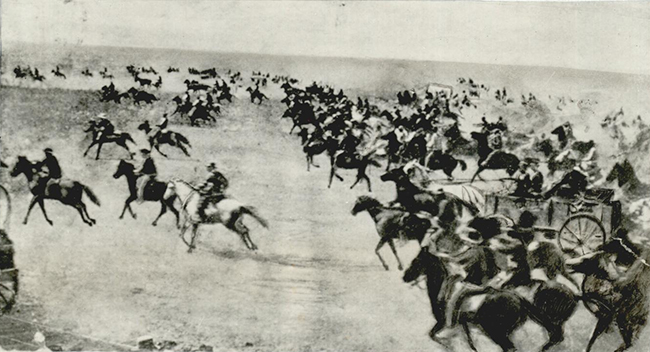When First American people were removed from their homelands in the southeast following the Indian Removal Act of 1830, they were promised that the land in Indian Territory would be theirs "for as long as the stars shall shine and the rivers may flow [1]". But, by the 1870s, the continual march of settlers westward clearly showed that this promise was being threatened. It seemed that it was only a matter of time before their land would once again be taken by white settlement.
Legislative Encroachment
Over time, Congress passed a substantial number of acts with the same name—with each having a negative impact on First American tribes. Those acts were called the Indian Appropriations Act of 1851, 1871, 1885, and 1889. At the end of their 1889 session, Congress added an amendment to the Indian Appropriations Act of that year. The amendment paid the Creeks and Seminoles for any of their claims left lingering in the Unassigned Lands. The amendment also directed President Grover Cleveland to set the date for when homesteaders could enter the territory. He chose April 22, 1889. Anyone entering before that time would be ineligible to make a claim.
Preparation by First Americans and Other Ranchers
In anticipation of this, Montford T. Johnson and many other ranchers were told to remove their livestock from Oklahoma Territory and drive the herds back into Chickasaw Nation territory. It was a difficult undertaking. The removal of cattle was not without harassment from the soldiers stationed at Fort Reno. The times were tense, but the Johnsons made an appeal to Lt. Colonel E.V. Sumner requesting that additional time be allowed for the removal of their herds.
They also asked that Sumner issue an order to end the harassment by the soldiers [2, p. 211]. He granted both requests.
Land Run Set
On March 23, 1889, newly elected President Benjamin Harris signed a proclamation moving forward the opening of 2 million acres for settlement in the Unassigned Lands. Bowing to pressure brought by non-First American settlers, railroad interests and merchants, Harrison justified the action based on the Homestead Act of 1862, which held that any legal settler could claim 160 acres of public land for farming and development. Thirty-one days later an estimated 60,000 homesteaders had gathered at the Kansas and Texas borders—waiting for the clock to strike noon and the race to stake a claim.

Photo courtesy of the Oklahoma Historical Society
Weeks before this initial run, “Boomer” cities were formed all along the perimeters of the starting locations. There were many “Sooners” who would secretly cross the border and stake out premature claims.
By nightfall on the day of the run, thousands of claims had been made either on town lots or on quarter section farm plots. The towns of Oklahoma City, Guthrie, Kingfisher, Norman and others sprang into being overnight [3].
Further Land Runs in Indian Territory
The four notable land runs that followed the 1889 run involved land that belonged to tribal nations as well. The Land Run of 1893, often called the Cherokee Strip Run, was the largest of all. Over 8,144,682.91 acres, purchased from the Cherokee Nation, was staked and claimed. It was the largest land run in U.S. history, four times larger than the Land Rush of 1889 [4].
The effects of the Land Runs were detrimental to all of the First American Nations located in Indian Territory. There was a breakdown of law and order, theft of cattle, equipment, crops and food. Destruction of homes and property were common. This threatened to destroy the peace, security, and welfare of Native people [1].
[1] "Oklahoma Land Runs," [Online]. Available: https://skmantle.weebly.com/native-americans-and-the-land-run.html. [Accessed 25 8 2021].
[2] N. R. Johnson, The Chickasaw Rancher, Boulder: University Press of Colorado, 2001.
[3] History.com, "The Oklahoma Land Run rush begins," [Online]. Available: https://www.history.com/this-day-in-history/the-oklahoma-land-rush-begins . [Accessed 25 8 2021].
[4] D. Everett, "Land Openings," Oklahoma Historical Society, [Online]. Available: https://www.okhistory.org/publications/enc/entry.php?entry=LA016 . [Accessed 25 8 2021].